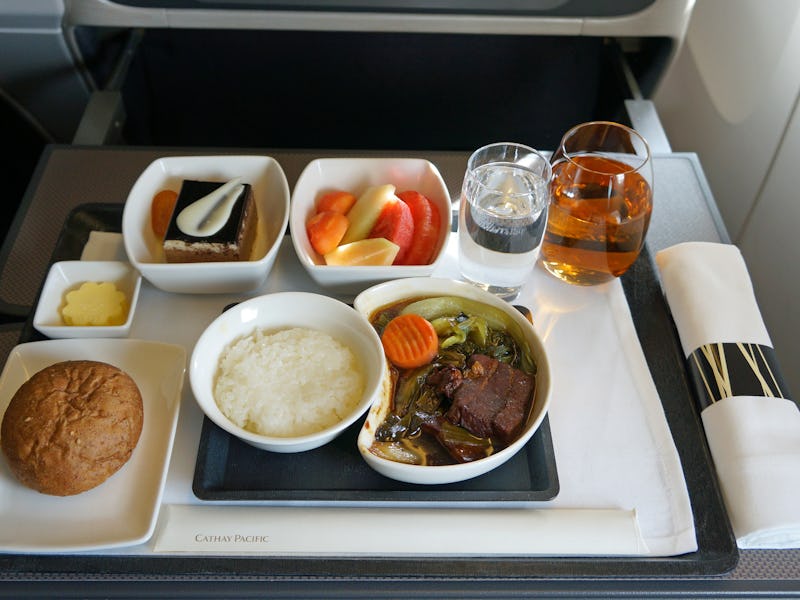Cut airline chefs some slack. Yes, they’re to blame for whatever lurks in the ceramic tray beneath the foil, but every damp Salisbury steak served at 30,000 feet is a minor miracle. Airline chefs are contending with two major obstacles: there are no kitchens at altitude and their clients can’t taste properly. And the chefs are, for the moment, overcoming. The food is getting better.
Studies have shown that the high altitude, low cabin pressure, and cold temperatures we experience on an plane all affect our sense of taste. Under those conditions, taste buds go numb. It doesn’t help that the cabins have such low humidity (less than 20 percent) that it dries our noses out, messing with both our sense of smell and taste. A recent study showed that even the noise level on a plane has an effect, enhancing “umami” and dulling sweetness.
And then there is the cold. Chefs might fight against it.
“It doesn’t matter if you’re 30,000 feet up on an airplane or three feet up on a boardwalk,” Chef David Kamen of the Culinary Institute of America told Inverse. “If the food has to go through that preparing, cooling, holding, reheating process, it’s going to diminish in quality right there.”
To fight the dual threat of weakened palates and reheating, chefs like Kamen use these strategies:
Heavy-Handed Flavoring
Our sensitivity to salt and acidity is altered in the air, so chefs need to strike a delicate balance between compensating for lost flavor and oversalting. Often, it’s less about changing a recipe and more about choosing the right dish. Some meals simply can’t get off the ground.
When developing a menu, chefs “try to find those dishes that more naturally have that bigger, bolder flavor system.” said Chef Kamen. Regional foods, like Mediterranean, Asian, and Southwestern cuisines tend to do better because their relatively high acidity stimulates the palate. Once the acid hits the tongue, it triggers the flow of saliva, which moistens dried-out sinuses, helping fliers pick up on the food’s aromas.
Cooking Technique
There are a lot of foods that can’t withstand the cooking, chilling, and reheating process. Fried foods, for one, will inevitably end up soggy, and pasta and rice are especially tricky to reheat because their textures are so dependent on moisture.
On an episode of Top Chef Canada that required contestants to cook a two-course airline meal, one chef wrestled with how to reheat polenta, a cornmeal dish typically resembling a creamy porridge. When faced with these situations, the question chefs need to ask, according to Chef Kamen, is: “How do we take our choices and make them work?” For example, instead of serving polenta the traditional way, he suggests flattening it out into sheets to make “noodles” for a (gluten-free) lasagna. Faced with similar issues with risotto, he instead turns it into fried croquettes.
Fruitier Wines
Wines aren’t immune to the effects of high-altitude travel. In flight, passengers are more sensitive to the acids and tannins in the wine, whereas delicate fruit flavors fade. Using the same mentality they use in seasoning their dishes, chefs select wines that have big flavor and a lot of character, such as a sweet, fruity merlot or a pinot noir, to stand up to customers’ altered palates.
Mastering Meat
Have you ever tried to reheat a day-old grilled chicken breast? Exactly. Sawdust. It’s hard to serve meat on a plane because it so rarely survives the reheating process. Some cuts, like American beef tenderloin, may hold up better than others because of higher fat content, but it’s still tricky to get right. Brining a piece of chicken in a salt-water solution helps, as can marinating other pieces of meat, but no matter what, meat always starts at a deficit.
The best thing to do is think of the meat as a garnish rather than as the star of the show. That way, it can be incorporated in dishes such as salads, tagines, or stir-frys.
“If it’s all about the chicken, and the chicken is no good,” says Chef Kamen, “then the whole thing is no good.”
